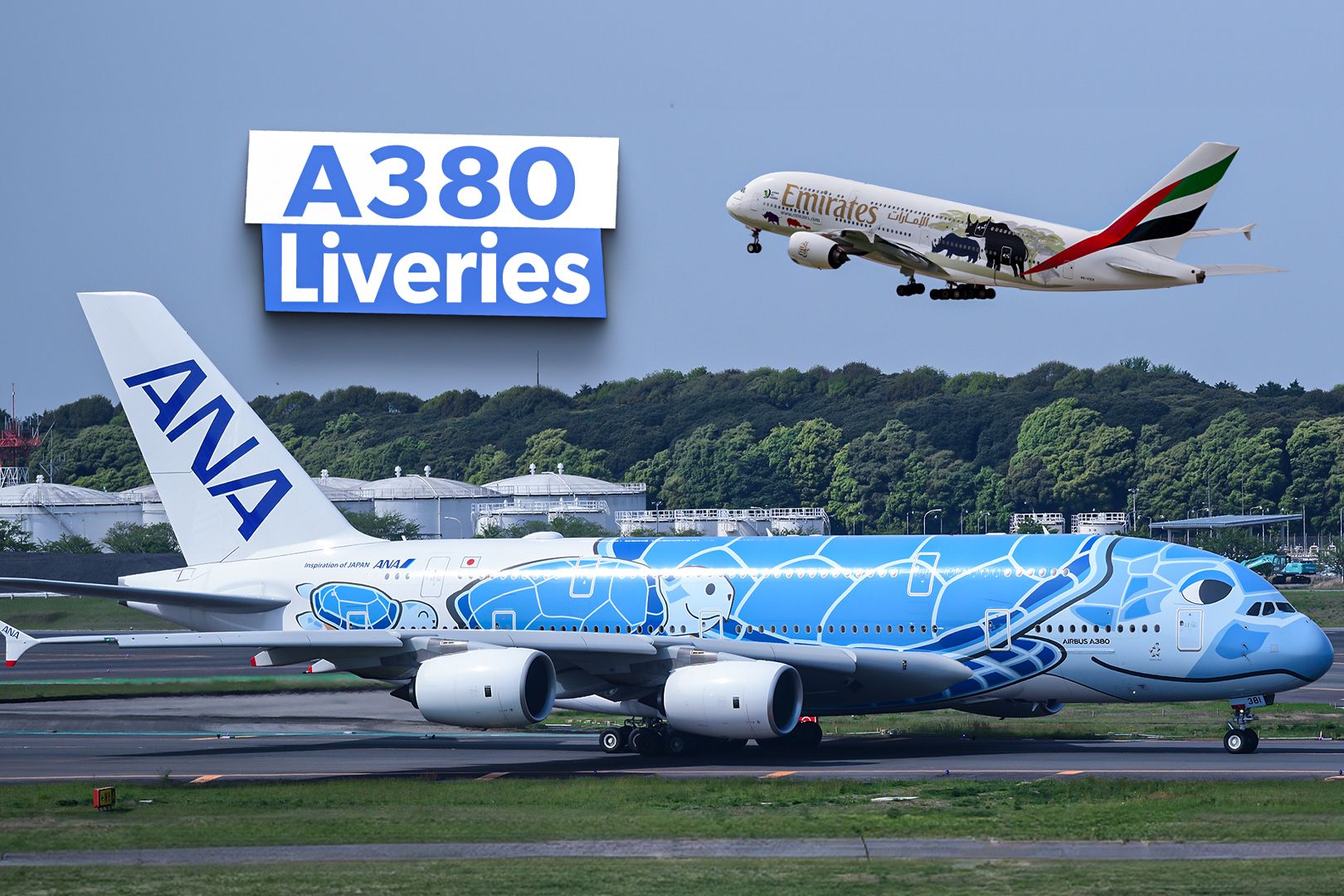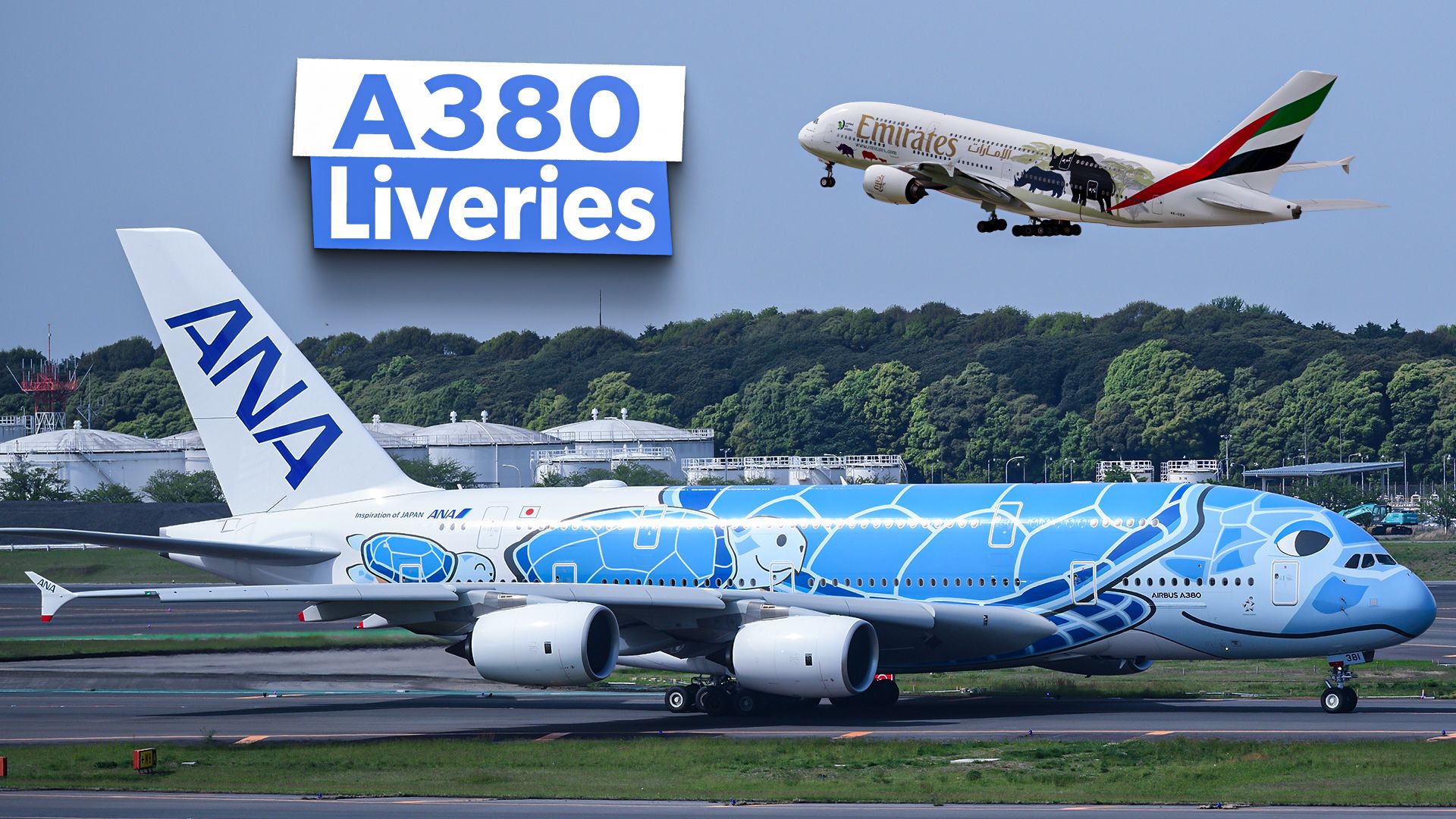
Despite Airbus
ceasing production of the A380
in 2021 due to shifting market dynamics and the rise of more fuel-efficient twin-engine aircraft, several major carriers continue to operate it.
At the time of writing, September 2024,
Emirates is the largest operator of the A380
(94 aircraft on ch-aviation, 121 on Flightradar24) and other operators with active A380 in their fleet include:
- British Airways (11 aircraft on ch-aviation, 12 on Flightradar24)
- Singapore Airlines (9 aircraft on ch-aviation, 17 on Flightradar24)
- Qatar Airways (7 aircraft on ch-aviation, 8 on Flightradar24)
- Qantas (7 aircraft on ch-aviation, 12 on Flightradar24)
- Lufthansa (6 aircraft on ch-aviation, 11 on Flightradar24)
- Asiana Airlines (6 aircraft on both websites)
- Korean Air (5 aircraft on ch-aviation, 8 on Flightradar24)
- Etihad Airways (4 aircraft on ch-aviation, 5 on Flightradar24)
- ANA—All Nippon Airways (3 aircraft on both websites)
But which are (or were) the best-looking liveries to grace the Airbus A380’s fuselage?
5
ANA ‘turtle’ livery
Hawaii’s spirit has been encapsulated by All Nippon Airways (ANA) with its Airbus A380 fleet, dubbed “FLYING HONU.” Since their launch in May 2019,
these aircraft have been decorated with sea turtle liveries
, each representing a distinct feature of the Hawaiian landscape.
The orange livery invokes the island sunsets, the green represents the waves of the Pacific Ocean, and the blue symbolizes the magnificent skies of Hawaii.
The A380 is adorned with a giant, happy turtle on the front and smaller turtles at the rear, which represent prosperity and good fortune. The Honu also means longevity, security, and mana (spiritual energy).
Despite the epidemic, ANA operated these unusual aircraft for special events, and
in 2023, it started operating regularly for passengers again
.
The FLYING HONU A380s operate on the Tokyo-Honolulu route, offering 520 seats in a four-class configuration, catering to the high demand between Japan and Hawaii.
4
Thai Airways standard livery
Even though the airline’s logo has changed since its debut, Thai Airways’ livery still includes significant elements that are indicative of Thai culture.
Thai Airlines’ livery is meaningful and combines contemporary style with traditional Thai culture. Introduced in 2006, with the airline’s hub transfer to Suvarnabhumi Airport (in Bangkok, the capital of Thailand), the redesigned livery coupled with a broader brand renewal, including new aircraft, services, and seating.
The logo on the tail fin represents the traditional Thai ‘wai’ greeting, a gesture of respect where palms are pressed together in front of the chest, often accompanied by a slight bow.
On the other hand, the curved lines reflect ‘lamyong’. This architectural detail can be found on temple roofs and is a decorative structure sculpted in a serpentine ‘naga sadung’ shape, evoking the ‘Nāga’, half-human, half-serpent beings from Asian religious traditions.
The colors—gold for temples, magenta for magnolia blossoms, and purple for Thai orchids—connect the airline’s identity to Thailand’s cultural and natural beauty.
The Airbus A380 with this livery looked terrific, and its enormous size emphasized the design. Even though Thai Airlines no longer flies the A380 (and
has put its entire Airbus A380 fleet up for sale
), seeing this recognizable livery on such a magnificent airplane was always special.
3
Hi Fly Malta ‘Coral Reef’ livery
Hi Fly Malta’s Airbus A380, registered as 9H-MIP, became a global ambassador for environmental advocacy with its “Save the Coral Reefs” livery.
Estimates suggest that these ecosystems could disappear by 2050 if action is not taken. Coral reef destruction is a serious problem brought to light by this livery, developed in association with the Mirpuri Foundation (founded by Paulo Mirpuri, a Portuguese businessman and philanthropist).
Acquired in July 2018, the aircraft’s paintwork featured a powerful contrast: one side depicted a deteriorating ocean, while the other showed a healthy, vibrant reef, symbolizing the urgent need for action.
This A380 was used for several purposes, including passenger flights and humanitarian missions. Notably, during the COVID-19 epidemic, it was transformed into the world’s first cargo A380, aiding in transporting necessary supplies.
With its environmental message, the aircraft became one of the most recognizable A380s and created history by landing at over 50 airports on four continents.
In December 2020, the A380 made a heart-shaped flight path as part of a symbolic farewell in observance of its campaign. In 2021, the 9H-MIP,
after being repainted white
, was disassembled and scrapped in the facility of Tarmac Aerosave in Tarbes, France.
2
Emirates ‘United for Wildlife’ livery
The unique livery was unveiled in 2015, showcasing pictures of threatened animals like tigers, rhinos, and elephants. It is a powerful symbol in the struggle against the illicit wildlife trade and seeks to increase awareness of the poaching crisis on a global scale.
As part of a partnership with United for Wildlife, an international alliance backed by the Royal Foundation of the Duke and Duchess of Cambridge and Prince Harry, Emirates has spread its message worldwide.
The Dubai-based airline has pledged to prohibit trophy exports and teach employees to recognize illicit wildlife items. The airline aims to safeguard sensitive wildlife and disrupt the trade chain.
Last year, the airline also introduced new amenity kits
with endangered animals to raise awareness for wildlife conservation.
1
Etihad Airways (‘United Kingdom’ and ‘Choose South Korea’ liveries)
These two Etihad A380 liveries represented the airline’s “Choose United Kingdom” and “Choose South Korea” campaigns.
Big Ben, the London Eye, and traditional British guards were among the prominent icons of British culture featured on the first A380, registration A6-APE. These symbols applied to the enormous A380 and blended with the exquisite standard Etihad livery created a beautiful effect.
Two years ago, Etihad announced it would remove
four Airbus A380s from storage exclusively for London flights
. Given the intended destination, everyone hoped that the A380s with the unique “Choose The United Kingdom” livery (A6-APC & A6-APE) would be among the aircraft returning to service. On September 13, 2024, Etihad moved A6-APE from Teruel to Abu Dhabi, boding well for the future.
The second A380, registered A6-APD (still stored in Teruel, Spain), with the ‘Choose South Korea’ livery, showcased floral and bird motifs. The detailed artwork, made by recalling the ‘minhwa’ technique of Korean folk art, added a touch of artistry to the aircraft, making the aircraft even more elegant and paying tribute to South Korean culture.

